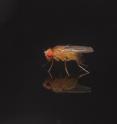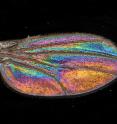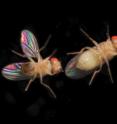Secret wing colors attract female fruit flies
Bright colors appear on a fruit fly's transparent wings against a dark background as a result of light refraction. Researchers from Lund University in Sweden have now demonstrated that females choose a mate based on the males' hidden wing colors. "Our experiment shows that this newly-discovered trait is important in female choice in fruit flies, and is the first evidence that wing interference patterns have a biological signalling function between the sexes during sexual selection," said Jessica Abbott, a biologist at Lund University.
The extremely thin wings of the fruit fly are transparent and apparently colorless. However, a few years ago researchers at Lund University discovered that the wings shimmer with beautiful colors thanks to a refraction phenomenon known as thin-film interference.
"Because the wings are transparent, these colors are only visible against a dark background," said Jessica Abbott.
The Lund researchers have now studied the significance of these interference colors on the wings of fruit flies. In the present study, the researchers have investigated whether the colors influence choice of partner, i.e. to what extent females use these colors to select a mate. The results show that the colors are important.
Wing interference colors are determined by the thickness of the wing. The colors are only found in small insects, particularly flies and wasps, which have wings that are only nanometres thick, i.e. not much thicker than a millionth of a millimetre.
Fruit flies have been used as laboratory animals in genetics research for almost 100 years and intensive studies have been carried out on sexual selection in the species, yet despite this the characteristics used in mate choice have remained uncertain.
"Our results will hopefully stimulate more research on wing interference patterns in other species, and increase interest in the role that the light environment plays in mate choice," said Professor Erik Svensson from Lund University.
Source: Lund University
Other sources
- Secret wing colors attract female fruit fliesfrom Science DailyWed, 22 Oct 2014, 18:01:47 UTC
- Secret wing colours attract female fruit fliesfrom PhysorgWed, 22 Oct 2014, 13:30:54 UTC


